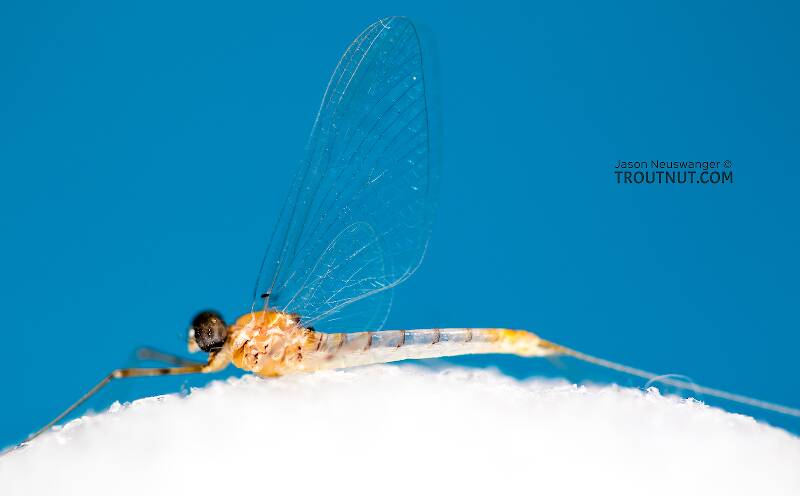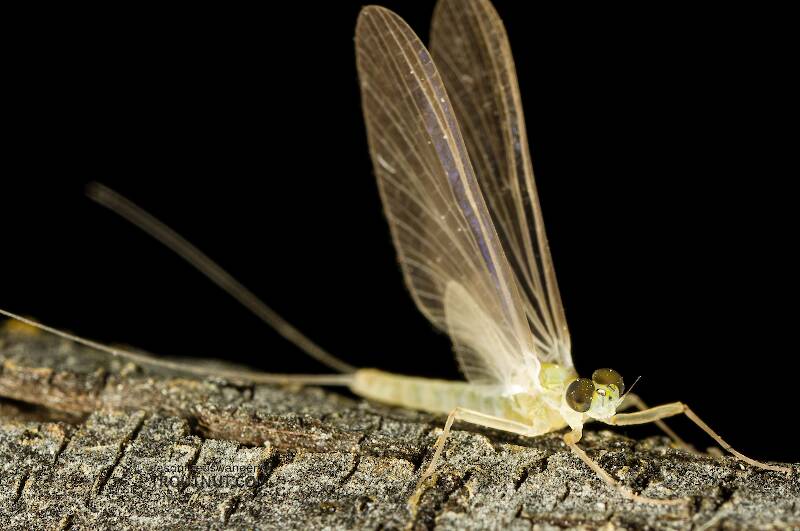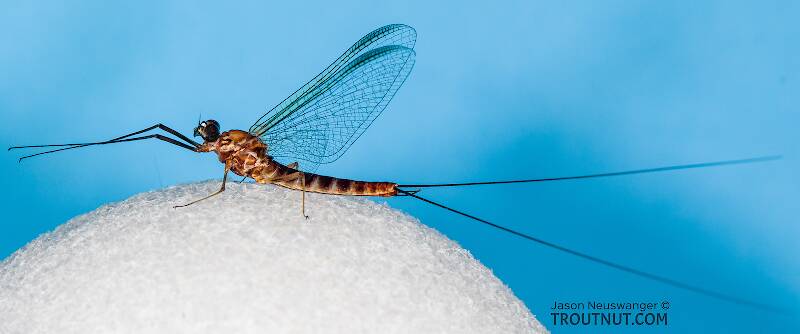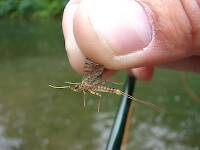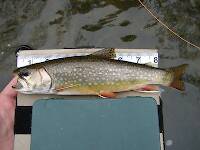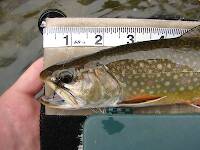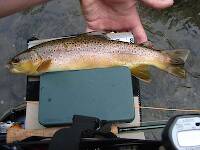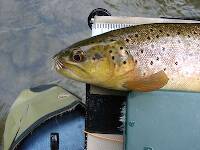
Hex Mayflies
Hexagenia limbata
The famous nocturnal Hex hatch of the Midwest (and a few other lucky locations) stirs to the surface mythically large brown trout that only touch streamers for the rest of the year.
Featured on the forum

This specimen keys to the Epeorus albertae group of species. Of the five species in that group, the two known in Washington state are Epeorus albertae and Epeorus dulciana. Of the two, albertae has been collected in vastly more locations in Washington than dulciana, suggesting it is far more common. On that basis alone I'm tentatively putting this nymph in albertae, with the large caveat that there's no real information to rule out dulciana.

Troutnut is a project started in 2003 by salmonid ecologist Jason "Troutnut" Neuswanger to help anglers and
fly tyers unabashedly embrace the entomological side of the sport. Learn more about Troutnut or
support the project for an enhanced experience here.
This topic is about the Mayfly Family Heptageniidae
Known as the "clinger" mayflies to anglers, a few species of this family can be extremely prolific, with a lot more that aren't. These lesser species account for many of the curious mayflies you find that never seem to associate with a major hatch, let alone a fishable one. Not all heptageniid species are so scarce though; there are superhatches too.Heptageniids can be broken into "groups" of similar genera (based on angling concerns) to help keep track of them. Although many of them are closely related, they are not officially divided in this way by entomologists. Here are the groups:
Stenonema (blotchy wings)
The genus Stenonema, who's Latin name was one of the first etched in the minds of anglers, was for a while largely reclassified into Maccaffertium but has since been reinstated. It includes the March Brown (S. vicarium) and Gray Fox (previously S. fuscum) superhatches.
The Stenonema species are for all practical purposes limited to the East and Midwest.
Former Heptagenia (plain wings)
While Heptagenia has held on to several species, many of its fishable hatches have been moved to the genera Leucrocuta, Nixe, and Ecdyonurus. Some species of Nixe were subsequently moved to Afghanurus. There are many former Heptagenia species across the continent, but few are important to anglers. Of those, more are in the West than in the East.
Epeorus (two-tailed Nymphs, plain wings)
The closely related genera Epeorus and Ironodes are among the only mayflies to have just two tails as nymphs. Good populations can be found in the West, but it's in the East where the mayfly named after the man that brought the dry fly to America can be found, the superhatch Epeorus pleuralis or Quill Gordon.
Rhithrogena (suction cup gills)
The genus Rhithrogena can be identified by the gills of its nymphs. They extend underneath the abdomen in the front and the back. They are very important for early season anglers in the West, but not very often in the East. For western anglers, it's duns are the blotchy winged equivalent of the East's March Brown (Maccaffertium vicarium). Ironically, it is only the Western March Brown that is in the same genus as the English species for which the common name originated.
Cinygmula (horn heads)
The genus Cinygmula is easily distinguished by the nymph's enlarged palpi (mouth parts) that stick out from both sides of their heads like little blunt horns. They rarely produce fishable hatches, and none are of much significance except for a few species, mostly in certain locales of the West.
Example specimens
LittleJ on May 18, 2007May 18th, 2007, 2:33 pm EDT
Just curious do vicarium have an orange egg sac. I got on the stream last night just before dark to catch the sulpher (I think invaria) spinner fall, and when I got there all I saw were swarms of orange egg sacks.IT was too dark to see the color of the fly, but I thought that sulphers were only yellow. Do they vary in color or was it vicarium.
Thanks
Jeff
Thanks
Jeff
GONZO on May 19, 2007May 19th, 2007, 7:16 am EDT
Interesting question, Jeff. The spinners you saw were probably invaria. Whether the sulphur eggs appear yellow or orange or yellowish-orange depends a bit on prevailing light and might even vary a bit from stream to stream. However, I don't think that M. vicarium females fly around with an obvious ball of eggs attached (at least I've never noticed this). Instead, I believe that the eggs are held inside the abdomen and expressed a few at a time as they dip to the water. The invaria females eject the whole ball, often well above the water's surface. (This behavior can be frustrating for trout and fly fishers, especially when few of the spinners actually fall to the surface. One clever and time-tested tactic is to imitate the egg ball with some dubbing on a 22-24 hook.) The M. vicarium females would also be noticeably larger than E. invaria and would have two tails rather than three. If anyone can confirm these egg-laying observations, I would appreciate it.
Martinlf on May 19, 2007May 19th, 2007, 7:28 am EDT
The observation about visible external invaria egg masses vs. internal vicarium eggs is very interesting to me. I may have mistaken invaria for vicarium a week or so ago. Thanks, Gonzo.
"He spread them a yard and a half. 'And every one that got away is this big.'"
--Fred Chappell
--Fred Chappell
LittleJ on May 20, 2007May 20th, 2007, 2:01 pm EDT
I was back out this evening, and the orange egg sacs were def. invaria. I got there a little earlier and saw them in good light. Thanks gonzo for clearing that up, you saved me from tying up a bunch of vicarium duns w/ orange egg sacs. And The egg sacs were almost "glo bug" orange so apparently they do vary in color.
Jeff
Jeff
Quick Reply
Related Discussions
Topic
Replies
Last Reply
10
May 24, 2009
by Wiflyfisher
by Wiflyfisher
Re: Salmonfly question for you westerners
In the Stonefly Species Pteronarcys californica by Troutnut
In the Stonefly Species Pteronarcys californica by Troutnut
7
Jun 4, 2016
by Chipper
by Chipper


